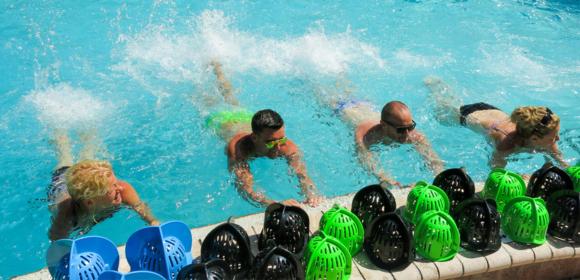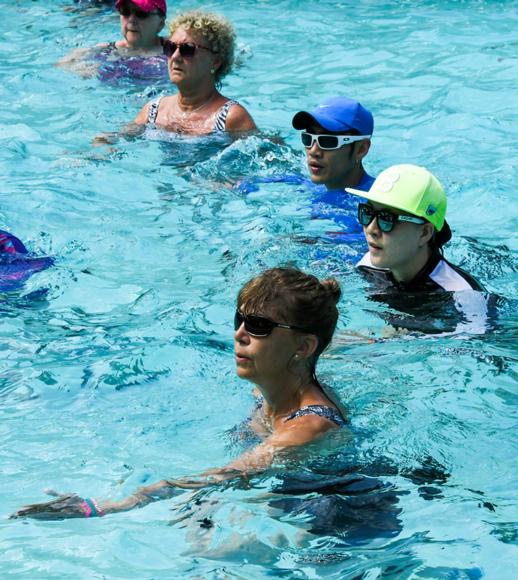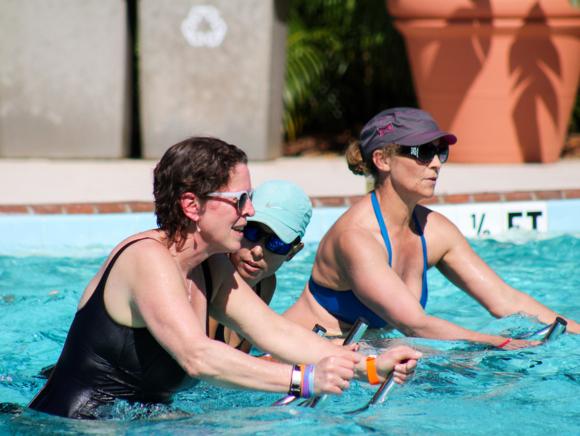Review some of the most common aquatic formats
This is an excerpt from Aquatic Fitness Professional Manual-7th Edition by .
Using the general recommendations for class components, you can design numerous formats to keep aquatic classes engaging, provide training variety, and motivate a wide range of participants. This section discusses some of the most common aquatic formats, many of which can be modified for shallow, deep, or transitional water depths.
Circuit Training
Circuit training is often referred to as station training. The stations can be cardiorespiratory, muscular fitness, flexibility, neuromotor, or any combination. The circuit format can be instructor guided, where everyone in the class is performing each station at the same time. You lead the group as each participant performs the same moves and uses the same equipment (if being incorporated) at the same time. The circuit can also be self-guided, with individuals or small groups rotating from station to station. A combination circuit combines these two options into one class; you lead the class in a cardiorespiratory segment and then the participants move individually or in small groups to various stations. Circuit training is very versatile, and is limited only by your creativity with the equipment available, your pool design, and your participants (figure 11.1). See appendix F for a sample shallow-water circuit-training workout.

Figure 11.1 Circuit training in the water, as on land, is only limited by your creativity with equipment and space.
Interval Training
Interval training is composed of a series of training cycles that include high-intensity (work) and low-intensity (rest) segments. Both work and rest are planned and functional. The work - rest ratio sets the foundation for interval training. Intervals can be aerobic or anaerobic in nature, resulting in different fitness outcomes for your class participants or clients.
Aerobic intervals would be arranged in a 1:1 (equal work and rest) or 12 (where work is shorter than rest). During anaerobic intervals, cue participants to work at or near maximal effort. Recovery can include light activity or total rest. During both aerobic and anaerobic intervals, heart rates will undulate, going up with the work interval and down during the rest interval.
Some very specific interval ratios include HIIT and Tabata. HIIT, or high-intensity interval training, is designed for participants to exercise at or above their maximal capacity; rest periods vary depending on the goals of the class. Tabata is a very specific set of eight intervals (20 seconds of maximal effort followed by 10 seconds of complete rest) completed in rapid succession. See appendix F for a sample deep-water HIIT workout. Examples of various types of intervals are included in table 11.4.

Dance-Oriented Programs
Some aquatic programs are geared to more highly developed choreography sequences of dance-oriented movements. The class components remain similar; the difference is found in the level of complexity in choreography, which challenges the participants both physically and mentally. A variety of dance-oriented classes target specific styles of dance, such as ballroom, ballet, and hip-hop, or various ethnic rhythms, such as African and Latin. All of these styles can be mixed and incorporated into your classes as appropriate for your participants. When introducing this type of class, more simplistic choreography patterns are recommended. Once your participants begin to look and feel confident in the movements and transitions, greater complexity can be added. It is also helpful to teach segments of the combinations during the warm-up to prepare participants for what is ahead. This prevents unwanted decreases in intensity levels during the cardiorespiratory segment of class. Using choreography styles such as pyramid or add-on can help ensure that your participants understand the pattern as you progress.
Striding (Walk and Jog)
Striding can be incorporated as a warm-up or cool-down for other class programs, or the entire class format may be designed around striding patterns. This format easily adapts to all water depths and pool shapes and sizes (figure 11.2). The choreography or movement patterns are typically simple, making the choreography easy to follow and easy to instruct. These classes can provide a great opportunity to work on walking patterns, proficiency, balance, and range of motion. Striding programs can encourage social interaction among participants while providing a chance to improve fitness. With simple modifications of intensity and impact, this format can be designed for all levels of participants. Underwater treadmills offer more options for classes that center around walking and jogging activities. See appendix F for a sample shallow-water striding workout.

Figure 11.2 A practical benefit of water walking is that it can easily adapt to all depths and sizes of pools.
Cycling
Stationary bikes designed specifically for the pool have become a popular training option for group exercise, personal training, and rehabilitation (see figure 11.3). With proper instruction, aquatic cycling can be a safe and effective option for all ability levels. Although similar to stationary cycling on land, pedaling while immersed takes advantage of the benefits of the aquatic environment. Resistance is determined by the unique design of the bike that increases drag resistance when pedaled; this resistance is adjustable on most styles of aquatic bikes. Resistance is also influenced by pedaling speed or revolutions per minute and by altering the body position on the bike. Aquatic cycling can achieve cardiorespiratory goals with continuous or interval training, or the goals may be more focused on muscular endurance or even strength. If your facility has a limited number of bikes, they can be set up as part of a circuit-training workout.

Figure 11.3 Stationary bikes designed for the aquatic environment have become popular.
Learn more about Aquatic Fitness Professional Manual, Seventh Edition.
More Excerpts From Aquatic Fitness Professional Manual-7th EditionSHOP

Get the latest insights with regular newsletters, plus periodic product information and special insider offers.
JOIN NOW
Latest Posts
- Authenticity was key to McKinney’s NIL success
- AI—A new tool for sport PR pros
- Essential skills for sport PR practitioners
- Employ these tactics when pitching a story to the media
- How does ergonomic analysis and intervention enhance safety and reduce injury risk?
- Common movement patterns in competitive cycling


